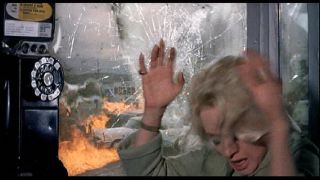The MacGuffin: News and Comment (13/Oct/2012)
(c) Ken Mogg (2012)
October 13
'Give them an inch and they'll take an ell.' The public - but also the media - is guilty of the sort of 'urban mythmaking' about Hitchcock that I started to describe last week and which, I fear, will continue to gather momentum, especially with the imminent screening of the slanted TV film The Girl on HBO in the US (on 20 October) and BBC2 (in December). That film is based on what Tippi Hedren and others told Donald Spoto and which he wrote up in his 2008 book 'Spellbound by Beauty: Alfred Hitchcock and His Leading Ladies'. (For a recent 'New York Times' interview with Tippi Hedren which gives the essence of her allegations against Hitchcock, [go here http://www.nytimes.com/2012/10/07/magazine/the-revenge-of-tippi-hedren-alfred-hitchcocks-muse.html]) Note that I hardly question the alleged facts themselves, for I greatly respect both Ms Hedren and Dr Spoto. The latter's Foreword to 'Spellbound by Beauty', summarising his position, is very plausible. Nonetheless, I remind everyone that all human perception is fallible and subjective. I'll come back to this matter. Meanwhile, I want to illustrate my point about the public and the media. Both of those entities will take far more than an ell, it seems. According to a friend, one afternoon last month on a Melbourne commercial radio station, 3AW, the program's host was talking to a guest film critic (name unknown). Hitchcock had been mentioned earlier and now the host, apparently with an idle moment to fill at the end, suddenly asked, 'Is it true that Alfred Hitchcock drilled holes in walls to spy on his actresses?' Well, that seems typical of the phenomenon I'm referring to. In this case, Kenneth Anger's fantastical embroidering on Rear Window and Psycho (see last time) was clearly having its effect. A lot of people are unable to distinguish between film and real life, and soon start to run the two together in their conversation and gossip (unless checked). A related matter is described in an article based on a recent interview with actress Kim Novak. 'As part of the PR campaign for Vertigo, Paramount leaked rumours of a feud on the set between Novak and Hitchcock, according to the book Vertigo: The Making of a Hitchcock Classic [1998] by Dan Auiler. Over the years, this marketing mischief has gelled into a legend of a fraught relationship between a dictatorial director and a wilful star. Nothing, Novak insists, could be further from the truth.' Hmm. That reminds me of how, for years, I kept hearing the rumour that Hitchcock delighted in ill-treating Novak on Vertigo by demanding endless re-takes of the scene in which she is rescued from San Francisco Bay (meaning, the studio tank). According to the rumour, up to 24 takes of the scene were shot - with no mention of how James Stewart would also have been required to dive back into the water each time! The rumour was finally scotched when the notes of Hitchcock's long-time assistant Peggy Robertson were examined. In fact, the scene was re-shot just four times, for perfectly valid reasons (see Robertson's obituary in the 'Los Angeles Times'). Even Dr Spoto himself has facilitated some anti-Hitchcock attitudes through his own negligence. His accusation that Hitchcock was cruel to his daughter Patricia, then appearing in his film Strangers on a Train, by ordering her held for half an hour on a stationary ferris wheel, seriously distorts what was just innocent fun, as described in Warner press release #3HO 9-1251. But now I come to The Girl. As I say, the basic facts concerning Hitchcock's sexual harassment of Tippi seem incontrovertible to me. Sad. But the new film distorts them, perhaps unforgiveably. In an article by Tony Lee Moral, due to be published in the 'Daily Telegraph' on 19 October, he reveals, for example, that the filmmakers allege that Hitchcock was angered when Tippi rejected an attempted kiss by the director while they were being driven around Bodega Bay during shooting of The Birds. Back at the studio later, while filming close-ups for the telephone-booth scene (see frame-capture last time), Hitchcock is alleged to have ordered a prop man to send a dummy bird crashing through the telephone booth's wall, 'shattering glass all over Tippi without any warning. The make-up people had to spend the rest of the afternoon picking tiny pieces of glass from her face.' The implication by The Girl is that Hitchcock was maliciously 'punishing' Ms Hedren. But how could anyone know that? (Besides, the scene called for a bird to strike the glass.) Those on the set are adamant that the broken glass was an accident. Very reasonably, hairdresser on The Birds and Marnie, Virginia Darcy, asks, 'Why would Hitchcock endanger his lead actress on a $3 million film', putting both film and actress at risk? Now, I have scarcely space left to make my main point. It would go something like this. The Hedren matter (as I call it) is a very small part of the total picture of Hitchcock that some of us have built up over the years. (I value this assessment by composer John Addison: 'Hitchcock was the most civilised man I have ever met.') Furthermore, as philosophers concerned with the 'big picture' tell us, all humans are flawed, often driven and misshapen against our wills by the cosmic Will itself (of which the sex-drive is a major manifestation). So maybe reflect a while on Hitchcock own words, 'Everything's perverted in a different way'. (My thanks to Tony Lee Moral for permission to quote from his forthcoming article. His exemplary book on Marnie is being revised for 2014 publication, and two other books by him on Hitchcock are coming shortly. Also, my thanks to BK who accessed the Warner files on Strangers on a Train at UCLA.)
This material is copyright of Ken Mogg and the Hitchcock Scholars/'MacGuffin' website (home page) and is archived with the permission of the copyright holder. |

